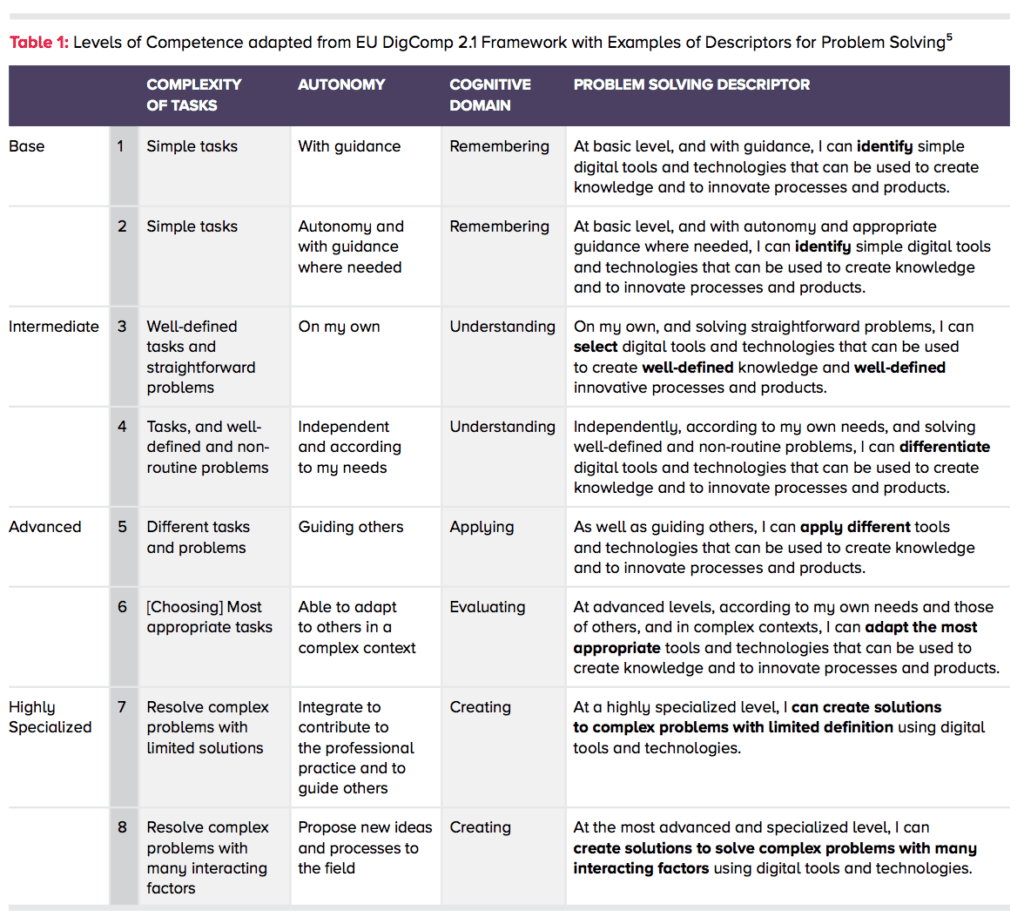Digital Skills Decoded
By Janet Lane, Director, Human Capital Centre
December 2019
Skip to PDF
What is the problem?
As workplaces increase the use of automation and other technological solutions, the demand for digital skills is growing. This is often interpreted to mean that more STEM (Science, Technology, Engineering and Mathematics) graduates are needed.
However, in this economy, every job is a digital job. The vast majority of jobs need people to have the skills and competencies to leverage technology to its best advantage. But what these skills are – and what level of skill is needed – remains unclear.
What is the solution?
We recommend that Canada builds and adopts a digital competency framework that can then be used to inform other competency frameworks. Competency frameworks identify the knowledge, skills and attributes and the levels of competence required to accomplish the tasks of every job in the economy. The digital competency framework should include definitions of digital competencies and criteria for assessing levels of competence. This will assist workers, employers and education providers to understand and meet the digital needs of the economy.
Discussion
Employment and Social Development Canada considers digital skills an essential skill. Virtually every job, even some that demand low levels of technical skills, requires workers to use a computer or handheld device. The use of mobile phone apps to record hours worked and tasks completed and to flag items that need attention has increased the digital skill demands of hotel room attendants. Truck drivers monitor the condition of their cargo through sensors attached throughout their semi-trailer. Fast food restaurants digitally link the front counter or order kiosks to the cooks in the kitchen.
Automation, Artificial Intelligence and other technological advances are making the jobs that were dull, dirty or dangerous vulnerable to disruption or elimination. New jobs and tasks that have been transformed by technology demand that workers have a variety of digital skills. Even the robots that have replaced some workers still need people to set up, operate, interact with and maintain them. When GE Canada brought in robots to do the hard, dangerous and demanding work of making airplane turbines, it retrained its workers to monitor, maintain and work alongside the robots.¹
The implication is that employers and individuals need to be open to and seek out opportunities to upgrade digital skills.
We reviewed six digital skills frameworks from around the world to identify which digital skills are in demand in economies similar to Canada’s and found six common competency groupings.² In keeping with European and Australian advances in the use of competencies, their frameworks are crafted as competency frameworks – not just a list of skills. We draw from these frameworks to describe the competencies:
01 Foundational digital skills
Everyone needs the most basic digital skills to function well in life and work.
This grouping includes the capacity to turn on a device, open and use a variety of applications, set up a Wi-Fi network and troubleshoot problems, and work across a variety of platforms to complete tasks. The U.K. government framework describes the basic skills required by the public in their daily lives and work, including the ability to register and apply for services, buy and sell goods and manage transactions.
02 Information and data literacy
Technology offers speedy access to sources of data and information. Recent advances in Big Data and machine learning drastically reduce the time it takes to process huge quantities of data.
Information and data literacy involve the articulation of information needs and capacity to search for, locate, retrieve, store, manage and organize digital data and information. It also includes the ability to analyze and interpret data and information and to critically evaluate and judge the reliability and credibility of the sources.
03 Communication and collaboration
From text messages to major presentations, from planning a family outing to managing a global project, software applications make it easier to communicate and collaborate.
The competencies for communication and collaboration using technology include the capacity to communicate in the digital workplace using the most appropriate tools, in ways that suit the audience, context and channel, and to participate effectively in digital teams and working groups to produce shared materials.
04 Problem solving
Technology can be leveraged to devise novel or innovative ideas, solutions and ways of working.
This grouping incorporates the identification and use of appropriate software or applications to perform job tasks, create knowledge, innovate processes and products and improve productivity.
05 Digital content creation
Emails, texts, letters, presentations, videos and photographs are digital content that most of us have learned how to create. At the highest level of this grouping of digital skills is the development of new software programs and applications, something not required by most jobs in the economy.
The common competency of this grouping is using the appropriate digital tools to generate new digital content and knowledge through the organization, integration, adaptation and application of digital information.
One framework incorporates programming – the capacity to plan and develop a sequence of understandable instructions for a computing system to solve a given problem or perform a task. “Development of understandable instructions for a computing system” is code for coding. While being able to code is becoming more of an asset in jobs that are not considered Information Technology jobs, most workers do not need this skill, yet.
06 Digital safety
Malware, phishing, trolls – learning the language of the bad things that can happen when using technology is a digital skill in itself. Being safe in the digital world includes ensuring passwords are protected, and security measures to protect hardware, software applications, data and personal information are followed. This includes when using social media.
Levels of skill
The levels of digital skills required for jobs fit on a continuum. They range from the basic to software engineering and application development. The majority of people in the workforce today require digital skills at the low- to mid-range of the continuum.

While jobs have become more digitally intensive over time, 78 per cent of jobs in the U.S. were still in the low and medium ranges of digitalization as of 2016.³ Low digital skill occupations include security guards, welders, construction labourers and home-care workers. Medium digital skill occupations include automotive service technicians, registered nurses, office clerks, and tool and die makers. Digitalization is progressing rapidly, and occupations can become more digitally intensive quickly. Tool and die making was in the low end of the low-range in 2002 and the high end of the mid-range by 2016.?
Competency frameworks describe the competencies required to achieve the tasks of jobs within the framework. Behind each competency there should be a set of criteria for judging what competent looks like at each level. Digital competencies and their levels need to be part of all job-based competency frameworks.
Assessing levels of competence for digital skills combines the complexity of the task and the autonomy of the worker.
The required competencies and levels can be customized to particular jobs within a specific workplace. Employers and workers presented with this type of rubric for all the competencies of a given job can determine which competencies people need and to what level and where there might be gaps and learning requirements.
Developing digital skills in Canada
Employers making the move to incorporate more digital technologies will not be able to lay off existing workers and hire people with appropriate levels of digital skills. People with those skills are most likely already employed. Instead, they will need to offer their current workforce opportunities to build the needed skills. AT&T in the U.S. realized this and in 2013 it began the $1 billion process of upskilling 100,000 employees.? New ways of learning skills will involve a combination of employer-led training, and personal lifelong learning.
To help employers understand the digital skills their employees need, Canada needs to build and adopt a digital competencies framework complete with levels of competence and criteria for assessing them. It should be updated regularly to include new skills required by jobs. A framework will help employers identify the digital skills their jobs demand now and in the future. Furthermore, the education and training systems across the country will have a better understanding of the skills their graduates need.
Conclusion
No matter which job a candidate is in or wants to qualify for, possessing at least a basic level of digital skill will be a major part of the job description. Knowing which skills they have, at what level, and gaining an understanding of how that needs to change is crucial. To win with the digital transformation that is happening ever faster in today’s workplaces, both individuals and employers will need to ensure that opportunities for upskilling of digital skills continue.
¹ Elyse Allan, former CEO, GE Canada, Max Bell Foundation Policy Forward speaker series, December 2017
² Chris Chinien and France Boutin. Defining Essential Digital Skills in the Canadian Workforce: Final Report. HRSDC. 2011. http://en.copian.ca/library/research/digi_es_can_workplace/digi_es_can_workplace.pdf
Essential Digital Skills Framework. Crown Copyright. U.K. 2018. https://assets. publishing.service.gov.uk/government/uploads/system/uploads/attachment_data/ file/738922/Essential_digital_skills_framework.pdf
Building Digital Capabilities: The six elements defined. Jisc. U.K. (http://ji.sc/building-digicap)
Skills in the Digital Economy: Where Canada stands and the way forward. The Information and Communications Technology Council. 2016. https://www.ictc-ctic.ca/wp-content/uploads/2016/05/Skills-in-the-Digital-EconomyWhere-Canada-Stands-and-the-Way-Forward-.pdf
Carretero, S. Vourikari, R. and Punie, Y. DigComp 2.1: The Digital Competence Framework for Citizens: With eight proficiency levels and examples of use. EUR 28558 EN. doi:2760/38842
Elizabeth Marsh. The Digital Workplace Skills Framework: Ensuring the workforce is ready to work digitally. Digital Work Research. Australia, 2018
³ Muro, Mark. et al. Digitalization and the American Workforce. Metropolitan Program at Brookings. 2017
? ibid
? Carretero, S. Vourikari, R. and Punie, Y. DigComp 2.1: The Digital Competence Framework for Citizens: With eight proficiency levels and examples of use. EUR 28558 EN. doi:2760/38842
? https://www.aspeninstitute.org/of-interest/upskilling-news-att-invests-1-billionemployee-reskilling/
